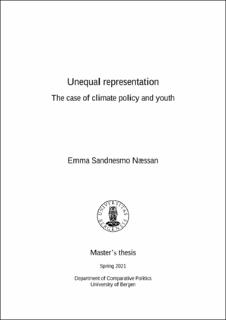Unequal representation: The case of climate policy and youth
Master thesis
Permanent lenke
https://hdl.handle.net/11250/2771656Utgivelsesdato
2021-07-02Metadata
Vis full innførselSamlinger
Sammendrag
A growing body of research finds that representation is real, but likely unequal. Policy is shown to disproportionately follow the preferences of some societal groups, most notably the rich, in advanced democracies. This thesis advances a little explored phenomenon in this line of research. I argue that it is important to analyze representation in climate policy and that age, which is often neglected as a parameter in its own right, may be an important cleavage within this field of policy. Climate reports highlight that there is more action to be done to mitigate climate change, and that policy is not implemented at sufficient pace. The last years have shown large-scale protests and actions where youth are actively engaged in climate change mitigation, demanding more governmental action. Literature shows mixed findings regarding preferences for climate policy across age groups, and it will therefore be interesting to see whether climate policy follows preferences preferring less climate policy or status quo, and whether these are the indeed the preferences of the older age groups. To test whether unequal representation is a feature of climate policy, I collect survey data on spending preferences and match them to corresponding climate policy in advanced democracies over the last three decades, to see whether policy (equally) represents preferences by age groups. This is done by creating a tailored dataset with aggregated preferences at country-level and analyzing the effect of preferences on different policies utilizing a quantitative approach. Second, I will test whether unequal representation in climate policy is mitigated by descriptive representation of youth in parliaments. The results suggest that climate policy partly follows average preference, whereas the results are mixed for unequal representation. For some issues, the policy reflected preferences of the younger age group, and for others it reflected the preferences of the older age group. Surprisingly, the preferences of the old were on average more “climate friendly” than those of youth for a minority of the issues considered. A stronger presence of younger parliamentarians showed the expected relationship, where a preference for increased output is associated with more output. Thus, based on the analyses, the thesis cannot conclude that there is unequal representation of age groups. Future research should aim to analyze more data and provide a fuller account of representation in climate policy.
